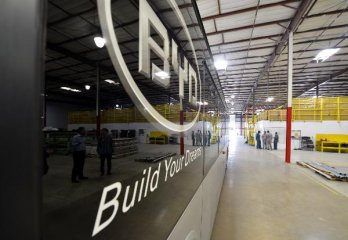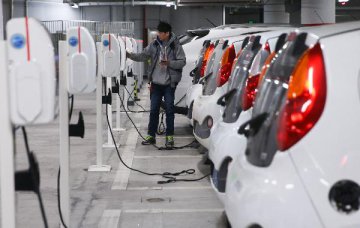
New energy, intelligence and light weight are recognized as the orientation of the development of the vehicle industry in the future. With the acceleration in the industrial transformation and upgrading, new materials for vehicles are attracting more attention. The potential market may reach trillions yuan.
New materials listed in medium- and long-term development plan
The Ministry of Industry and Information Technology (MIIT), the National Development and Reform Commission (NDRC) and the Ministry of Science and Technology (MOST) jointly released the Plan on the Medium- and Long-term Development of the Vehicle Industry (the Plan) in end-March. According to the Plan, light weight is recognized as a key orientation for the development of the vehicle industry. Advanced materials for vehicles are important contents in the Plan.
According to the Plan, it will rely on national technology plans to guide the cooperation between the vehicle industry and relevant industrial associations. They will coordinate in the research on the industrialization and bulk application of high-strength steel and high vacuum pressure casting of aluminium alloy, speed up in the application of magnesium alloy and rare earth magnesium (aluminium) alloy and expand the application of high-performance engineering components and compound materials. Enterprises will be encouraged to make technical breakthroughs in the manufacturing of key components and conduct integrated innovation and application of advanced manufacturing equipment.
It is learnt that the light weight of vehicles mainly depends on the application of improved design, alloy materials and non-metal materials, which can reduce the weight of vehicles by 10 to 15 percent, 30 to 40 percent and 45 to 55 percent.
The Chinese vehicle industry is under the strategic period of transformation and upgrading, indicated Yu Kai, Party Secretary of China Automotive Technology & Research Center, at the 2017 International Forum on China Automobile Material. With the integration of the new-generation information technology, new energy and new materials with the vehicle industry, the industry is under profound reform and the completion will be reshaped. It is significant for the Chinese vehicle industry to conduct active innovation and master opportunities. The Plan proposed to promote relevant enterprises strengthening the integration of technologies and capitals, which set the orientation for the development of the Chinese vehicle industry and proposed new requirements on the development of automobile materials.
Yu indicated that automobile materials are closely related to the safety, environmental protection, energy-saving and other performance of vehicles. Advanced vehicle industry in Europe, the U.S. and Japan have high requirements on automobile materials. China lags behind in the automobile materials industry with weak foundation. As a result, it has to conduct deep cooperation between vehicles manufacturers and research institutes to develop new materials and technologies.
Lightweight vehicles are significant
As a key means in energy saving and reducing emission, the light weight has been an orientation for the development of the vehicle industry. Henry Ford, founder of the Ford Motor, indicated that any unnecessary weight is fetal to vehicles. With the development new-energy vehicles, light weight will catch more attention.
Lightweight new-energy vehicles can increase the endurance and reduce the cost, indicated Zhao Pizhi, an assistant chief engineer at the Chinese Academy of Sciences. A reduction of 100 kilograms can increase the endurance by about 10 percent. Meanwhile, as the weight of vehicles becomes lighter, the weight of batteries can also be reduced and the cost will be reduced. In addition, it can reduce the braking distance and improve the safety performance. If the engine cover adopts aluminium alloy, it can better protect pedestrians.
According to the technology roadmap for energy conservation and new energy vehicles, which was released by SAE-China previously, weight of vehicles will be reduced year by year in three stages. The car will be 10 percent, 20 percent and 35 percent lighter than that in 2015 in the first stage during 2016 and 2020, in the second stage during 2021 and 2025, and in the third stage during 2026 and 2030 respectively.
Besides, lightweight is also directly related with energy conservation and emission reduction. According to the Plan, average oil consumption of vehicles should be cut to 5L per 100 kilometer by 2020. By estimation, if weight of a car is reduced by 10 percent, fuel efficiency can be improved by 6-8 percent. If oil consumption decreases to 0.3-0.6L per 100 kilometer, emission of carbon oxide will drop to 5-9 grams.
Yu said that lightweight of vehicles was not only regarded as core technology of new energy vehicle development in Made in China 2025 and was also repeatedly mentioned in proposals by MIIT, NDRC and MOST. But realizing lightweight cannot do without application of lightweight material such as high-strength steel, magnesium alloy, high-performance plastic and carbon fiber composite material. Innovation and development of material technology have become important methods to boost lightweight technological revolution.
Accelerate green manufacturing
Driven by transformation and upgrading of automobile industry, market size of automobile new material industry is predicted to reach several trillions yuan. But industry insiders thought that China still fall behind developed countries in lightweight and automobile new materials. Specifically, there’s huge gap between China and foreign countries in terms of varieties, quantity and performance of material. As China’s automobile industry and especially joint-venture brands have their own supplier system, it is very difficult for China-made material enterprises to be involved in the industry, making domestic material enterprise lag behind automobile industry. It is hard to control costs of materials and processing. Low processing efficiency of composite material increases costs of auto parts and original equipment manufacturers. There’s no complete standard for new material technology and products in China, and automakers and material enterprises are not integrated enough.
Gao Yunhu, a department director at the MIIT, indicated that China will beef up building green manufacturing system for automobile industry to reduce emission, costs and consumption and improve quality and efficiency. As China is under new normal, new impetus of green development should be nurtured. As a pillar industry of China’s national economy, automobile industry has long industrial chain and covers a wide range. Therefore, it is of great practical significance and profound historical significance to advance green manufacturing of automobile industry to achieve green development.
It is learnt that the planning proposes to boost target and major tasks of green development of automobile industry and also raise specific requirements on fuel consumption of vehicle, vehicle recovery utilization rate and green management for full life circle. Analysts indicated that strengthening green management for full life circle of vehicle means remarkably improving automobile fuel efficiency and greatly lowering emission and energy consumption and promoting green design of vehicle and green supply chain so as to establish green manufacturing system of automobile industry.
Translated by Star Zhang
























Latest comments